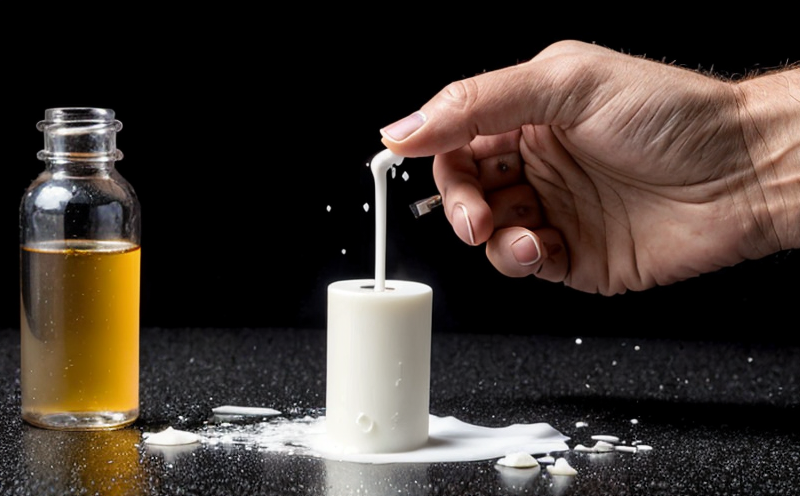USP Disintegration of Sublingual Films Testing
The USP Dissolution and Disintegration testing methods are critical in ensuring that pharmaceutical products meet quality standards and deliver the expected therapeutic effect. One such method is the USP disintegration test for sublingual films, which ensures that the film breaks down quickly upon contact with saliva to release its active ingredients promptly.
The USP disintegration test involves placing a specified number of sublingual films into a dissolution apparatus containing water at 37°C. The apparatus is then rotated or agitated for a set period, typically up to 15 minutes. During this time, the film must completely break down (disintegrate) into fragments small enough to pass through a sieve with a 450-micron aperture.
The test aims to evaluate not only the physical integrity of the sublingual film but also its ability to release active ingredients effectively. This is crucial for ensuring that the product meets the specified disintegration time limits outlined in USP monographs, which vary based on the intended use and formulation of the drug.
The choice of instrumentation is critical in this testing process. Typically, a basket-type dissolution tester or an agitated paddle system may be used to simulate oral conditions. The temperature and agitation rate must be precisely controlled to mimic physiological conditions as closely as possible. Calibration of equipment ensures accurate results, which are essential for regulatory compliance.
The USP 708 monograph provides detailed guidance on the testing procedure, including sample preparation, apparatus setup, and interpretation of results. The test should be conducted in a controlled environment to ensure consistency of results. Compliance with these standards is not only crucial for ensuring product efficacy but also necessary for regulatory approval.
Understanding the importance of this test extends beyond just compliance. It helps in optimizing formulation development by identifying potential issues early on, such as film thickness or composition that might affect disintegration times. This insight can lead to improved patient satisfaction and adherence due to faster delivery of therapeutic effects.
Scope and Methodology
The USP disintegration test for sublingual films is a part of the broader framework of pharmaceutical testing aimed at ensuring drug product quality. This section outlines the specific steps involved in conducting this test, highlighting key considerations that influence its outcome.
- Sample Preparation: Samples must be prepared according to USP guidelines to ensure consistency and accuracy. This includes standardizing the number of films tested, ensuring they are at room temperature before testing begins, and handling them gently to avoid any deformation or damage.
- Dissolution Apparatus: The apparatus used for this test can vary but must meet USP specifications. Commonly, a basket-type dissolution tester is chosen due to its ability to simulate oral conditions effectively. It ensures that the films are exposed to water at 37°C with controlled agitation.
- Dissolution Media: The dissolution media used in this test is typically water heated to 37°C, which simulates body temperature. This medium helps in evaluating how quickly and thoroughly the sublingual film disintegrates under conditions that mimic those found during use.
- Sampling Interval: Samples are taken at specific intervals throughout the test duration of up to 15 minutes. These samples help in assessing whether the film has completely broken down into fragments small enough to pass through a sieve with a 450-micron aperture.
The USP disintegration testing method is rigorous and provides valuable insights into the performance of sublingual films. By adhering strictly to these procedures, laboratories can ensure that they are delivering accurate and reliable results, contributing significantly to the overall quality control process in pharmaceutical manufacturing.
Environmental and Sustainability Contributions
- Eco-Friendly Materials: The use of biodegradable materials in sublingual films can contribute positively to the environment. These materials are designed to decompose naturally, reducing waste that might otherwise end up in landfills.
- Energy Efficiency: Modern dissolution testers and environmental chambers used in this test are often equipped with energy-efficient features that reduce overall power consumption without compromising testing accuracy.
- Water Conservation: By optimizing the amount of water used during the dissolution process, laboratories can minimize their water footprint. This is particularly important given increasing global concerns about water scarcity.
The USP disintegration test for sublingual films not only ensures product quality but also supports sustainability efforts by promoting the use of eco-friendly materials and efficient testing practices. These contributions align with broader industry initiatives aimed at reducing environmental impact while maintaining high standards of pharmaceutical quality.
Use Cases and Application Examples
| Product Type | Description | Testing Methodology | Outcome |
|---|---|---|---|
| Sublingual Film for Pain Relief | A fast-acting pain relief medication designed to be dissolved under the tongue. | USP disintegration test conducted at 37°C with agitation. | The film should completely break down within 15 minutes, ensuring rapid absorption of active ingredients for effective pain relief. |
| Sublingual Film for Cold Symptoms | An over-the-counter remedy designed to alleviate cold symptoms quickly. | Same as above, with specific focus on time-to-effect. | The film should show rapid disintegration and absorption, providing relief from symptoms within minutes of administration. |
| Sublingual Film for Heartburn Relief | A medication formulated to provide immediate relief from heartburn symptoms. | USP disintegration test is critical in ensuring quick release of antacid ingredients. | The film should rapidly disintegrate and dissolve, neutralizing stomach acid effectively within a short period. |
These use cases demonstrate the importance of the USP disintegration test in ensuring that sublingual films deliver their intended therapeutic effects efficiently. By adhering to this rigorous testing method, manufacturers can enhance patient satisfaction and ensure regulatory compliance.





